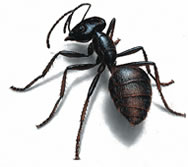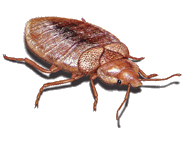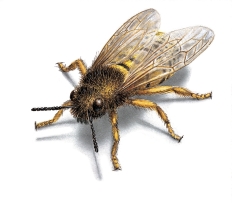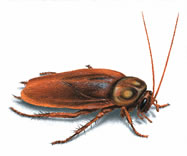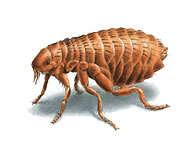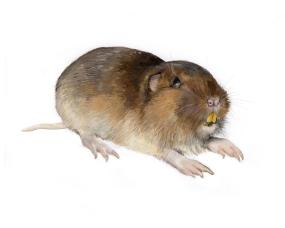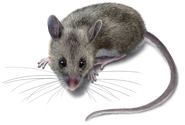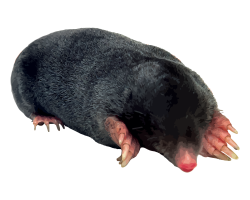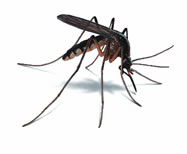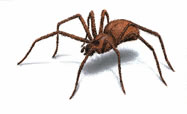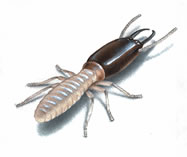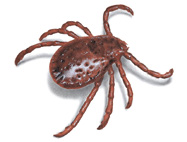West Oaks Pest Control
We're NOT Your Average Pest Control Company!
We're NOT Your Average Pest Control Company!
We Will Exceed Your Expectations!
For A Free Consultation
805-642-6077
Ants
Ants are the number one pest problem in the country. Ant control can be difficult, but there are some things you should know about how ants’ behavior can lead to big headaches for you and your home:
- Entry: Ants can enter through even the tiniest cracks, seeking water and sweet or greasy food substances in the kitchen pantry or storeroom areas.
- Scent trails: Ants leave an invisible chemical trail which contains pheromones for others to follow once they locate the food source.
- Nest locations: They can nest about anywhere in and around your house; in lawns, walls, stumps, even under foundations.
- Colony size: Can number up to 300,000 to 500,000 and whole colonies can uproot and relocate quickly when threatened.
- Colony Lifetime: A colony can live a relatively long lifetime. Worker ants may live seven years and the queen may live as long as 15 years.
- Do-it-yourself ineffectiveness: Most do-it-yourself ant control approaches only kill the ants you see. Some truly effective treatments can penetrate and destroy nests to help prevent these pests from returning. Also, home remedies don’t account for the fact that different kinds of ant infestations require different treatments.
Bed Bugs
Bed bugs are flat, reddish-brown, oval insects about 3/16-inch long or the size of an apple seed. Swollen and reddish after a blood meal. Bed bugs (often misspelled as bedbugs) are small, nocturnal, wingless insects that belong to the family of Cimicidae. They feed on human blood and other warm-blooded hosts. They are oval in shape and grow up to 4-5mm long when fully grown. Their skin color is rust brown to a deeper red brown. Bed bugs are also known as “mahogany flats”, “red coats” and “chinches.” The adult bed bug does not have any wings and has a flattened body. They live in the cracks and crevices including mattress seams, sheets, furniture, behind baseboards, electrical outlet plates and picture frames. Often found in hotels, where they can travel from room to room and in visitors’ luggage.
Bees
Found globally, bees are winged insects of the super-family Apoidea, order Hymenoptera. There are more than 20,000 recorded bee species. Chalicodoma Pluto, the largest of these creatures, is reported to be 1.6 inches long, while Perdita minima, the most diminutive of bees, are only 0.07 inches long. Bees can be black or brown with red, yellow or lustrous blue stripes. Some bees are notable for their ability to collect substantial amounts of honey. All bees are hairy, a trait which is crucial to the collection of pollen. Flowers and flourishing vegetation usually indicate the presence of bees: there is no insect as important as the bee when it comes to pollination. Many female bee species have rows of bristles on their hind legs which form a hollow basket. When the bee lands on a flower, pollen grains are combed into the hollow basket and bristles. Cross-pollination occurs when the displaced grains of pollen are distributed to the fertile pistils of other flowers as the bee alights upon them.Although only females are able to transfer pollen, all bees are able to sip the nectar from flowers using a tongue-like organ. This nectar is their primary source of energy. Pollen is sustenance for both adult and larval bees, as it contains protein and other nutrients necessary to their survival. Bees possess an organ that converts nectar into honey, which is collected depending on the species inside the hive, or bee colony.
While some bees are insular and solitary, species such as honey bees and bumblebees are tremendously social. Bee colonies are comprised of three castes: the queen bee, infertile female worker bees, and male drones. The queen mates and lays eggs for the span of her life. Queens can live up to five years, though most average a lifespan of two to three years. Male drones exist solely to fertilize the queen and die soon after having fulfilled their task. Female worker bees perform a multitude of tasks necessary to the survival of the hive. As a result of their constant laboring, their average life span is usually a mere six weeks.
Birds
It is difficult for some people to think of birds as pests. But a bird problem can lead to lost business, contaminated products and expensive damage to building exteriors. Certain species of birds have become recognized public health threats because they harbor disease organisms that can be transmitted to humans. Bird droppings are an added problem, signaling unsanitary conditions and eating away at building finishes. The droppings can also be expensive to clean up. West Oaks Pest Control can customize a bird control program that uses habitat modification to make your facility unattractive to birds.
Cockroaches
Cockroaches belong to Kingdom Animalia, Phylum Arthropoda, Class Insecta and Order Blattaria. Some species invade human dwellings and are considered pests. These cockroaches can be carriers of various diseases because they are commonly found near waste deposits or in the kitchen, where food is present. Restaurants may also experience cockroach infestations.
Cockroaches can measure over one inch in length, with tropical species tending to be larger than those found in other climates. Cockroaches have six legs, two antennae and wings. However, a number of winged cockroaches are not particularly adept at flying.
Cockroaches emit unpleasant odors and may also produce sound. The Madagascar hissing cockroach is the most famous of these vocal cockroaches, although more common species may produce quieter clicking or chirping noises.
Cockroaches can wreak havoc on your home. To win the war in cockroach control, here’s what you should know:
- Entry: Cockroaches can enter your home in many different ways, from the outside through cracks and crevices, vents, sewer and drain pipes. We even bring them in on products like grocery bags, boxes, purses and on our person!
- Ideal environment: Your home is an ideal breeding ground most species of cockroaches. With plenty of food, warmth, water and nesting sites, they can remain active all year round.
- Reproduction: Cockroaches reproduce quickly. For every one you see there can be many, many more hiding and multiplying behind your walls.
- Evasiveness: Because cockroaches are nocturnal, if you’ve seen one, you probably haven’t seen them all. The few cockroaches you see by day could mean they were likely forced out by overcrowding; a possible sign of severe infestation.
- Allergies/Asthma: The dust created by cast-off cockroach skins, dead bodies and droppings can aggravate allergies, especially in children and sensitive individuals.
- Do-it-yourself ineffectiveness: Cockroaches are better at hiding than you are at finding them, and their eggs are naturally protected from insecticides. Without special equipment, materials and know-how, cockroach control can be a losing battle.
Fleas
Fleas are external parasites which can be found attached to the skin of their hosts. Adult fleas measure approximately 1/8-inch in length. Their bodies are shiny and reddish-brown in color. They are covered with microscopic hair and are compressed to allow for easy movement through animal fur. Fleas do not have wings, although they are capable of jumping long distances. They have three sets of elongated legs. Read more about what fleas look like.
The cat flea is the most common flea in North America, although the dog, human, and sticktight fleas are also quite common. Fleas commonly attach themselves to dogs, cats, humans, chickens, rabbits, squirrels, rats, mice and other domesticated or wild animals.
The female flea lays her eggs on the surface hair of the host. Eggs then drop from the host and can infest carpets, bedding and furniture, hatching into larvae within 14 days. Flea larvae avoid light and feed on organic matter found within cracks and crevices. Usually within 18 days, larvae enter the pupal stage by constructing small, cocoon-like structures around themselves. Approximately two weeks later, adult fleas emerge and begin to search for food sources. Fleas establish large populations where pets and other animals, such as livestock, are present. Multiple treatment methods are often employed to eradicate a flea population.
Pets suffering from flea bites scratch themselves incessantly. Fleas also feed on humans and some people exhibit flea allergies. Fleas may also carry human diseases such as typhus and tularemia.
Gophers
Pocket gophers are medium-sized rodents from the family Geomys. There are varied species of pocket gophers. They range from about 5 inches to 14 inches in length. Their fur varies in color from black to brown to nearly white and is very soft. The pocket gopher got its name from the fur-lined pouches outside its mouth. These pouches are typically used for food transport. Pocket gophers are skilled burrowers and built for an underground life. Pocket gophers are well designed for their subterranean lifestyle. They have a short neck and powerful forequarters with large claws on the front paws. Their heads are small and flattened with small ears and eyes and lips which close behind the large incisors. Biology does vary slightly based on the species of pocket gopher. As an example, some have only a single litter of offspring each year while others can have two. The average size of a litter is three to four. Young pocket gophers don’t hang around home for too long, though. Typically, they leave the family unit in late summer to early fall and establish their own territories.The pocket gopher prefers to burrow in lawns and gardens. The tunnels can range from a few inches to a few feet in depth and several hundred feet in length.
A unique aspect of the pocket gopher’s burrow is the horseshoe shaped mound at the surface (moles construct volcano-shaped mounds at the surface of their tunnels). Pocket gophers are most active during the spring and fall when ground soil is primed for digging. These are solitary creatures that tend to be social only during mating season and child rearing. Control of these furry little pests can be challenging. If there are only a few pocket gophers invading your territory, trapping is the recommended method providing that it is in compliance with local regulations. Always check regulations for any local restrictions. Two of the most common traps in use are squeeze-type box traps and two-pronged pincer traps. The key to successful trapping is placement. Always locate the main runway. The type of trap will determine exact location, quantity needed, and if bait is necessary. Rodenticide baits are, also, an option. While these can be effective, these must be used in strict compliance with the label and regulations. If there is a large population of pocket gophers, more involved methods may be needed. Controlling large infestations may require the use of specialized equipment or fumigation. Home remedies, as often is the case, are rarely effective. Pocket gophers are a challenging pest to control once established. It’s recommended you contact a pest control professional for a full evaluation prior to any involved control efforts.
Mice
Rodents are warm-blooded mammals that, like humans, can be found throughout the world. They have oversized front teeth for gnawing and check teeth, which are adapted for chewing. Rodents chew on anything available to them and cause great damage in and around homes.
Rodents tend to be rapid breeders. Some species breed year-round. Although certain mice are known for short life spans due to predation, populations are maintained through constant reproduction. Because most rodents possess soft cartilage, they are capable of squeezing through spaces that appear to be much too small for them. All such holes should be stuffed with steel wool and sealed with spackle or cement to prevent entry and re-entry of rodents.
Mice may appear harmless, but they are known carriers of dangerous diseases such as Hantavirus. Hantavirus Pulmonary Syndrome is transmitted when urine and feces are disturbed. Utmost care should be employed when disposing of mouse droppings. They should be sprayed with disinfectant before sweeping them up.
Moles
Moles are from Order Insectivora and Family Talpidae. There are a number of species across the United States, but only three carry a reputation earning pest significance. The eastern mole (Scalopus aquaticus) is the most widespread and has the highest population count in the eastern United States. This species is the primary culprit for damage to lawns and gardens in the region. The most troublesome species spanning California is the broad-footed mole (Scapanus latimanus). Its close neighbor, the Townsend’s mole (Scapanus townsendii), resides primarily on the coast of Oregon and Washington. While the many species of moles have their individual characteristics, biology and behavior are similar.Surprising to some, maybe, but moles are not rodents. They are part of a group of mammals known as insectivores. The general characteristics of the mole, and more specifically the eastern mole, are a pointed snout, very large and rounded front feet with stout claws, and a short, bare tail. They grow to approximately 5-8 inches long with short, velvety fur which is grayish in color. Because of their subterranean lifestyle, eyes and ears are small and concealed by fur. Moles feed primarily on earthworms, ants, beetle grubs, and other arthropods living in the ground. A small portion of their diet does consist of various seed and vegetable matter, but they are not known to eat bulbs or roots of gardening plants.
Mosquitoes
We have all had to deal mosquitoes. The high pitched buzz tells us that we have mosquitoes nearby, and that we should beware since mosquito bites might not be far behind. Mosquitoes can chase us indoors during the best time of the year. Is there anything short of pitching a tent that you can do to take back your outdoor living space around your home?
Mosquitoes can be confused with flies. Mosquitoes have long legs, and a long proboscis or “nose” that female mosquitoes use to “bite” people and pets to draw blood, needed to lay eggs. Most flies won’t bite and even long legged flies are usually much smaller than mosquitoes. Mosquitoes are pesky pests and can spread disease such as West Nile Virus, dengue, and malaria. Believe it or not, there are over 1,000 cases of malaria every year in North America. More commonly, though, mosquitoes threaten family events more than health.
Rats
Black rats have long been named as the cause of the Black Death of the Middle Ages. While this plague is no longer as serious a threat to humans, roof rats are still carriers of disease. They may transfer diseases to both human and domestic animals.
The first step in controlling a roof rat infestation is to properly identify the rodents. Roof rats have hairless, scaly tails that are longer than their head and bodies. These rats are nocturnal and are excellent climbers. They leave oily marks on walls and dwell most commonly in attics or ceilings of buildings.
To prevent a colony from nesting in your home, make sure that all the windows and vents are screened. Roof rats can also enter openings in walls, eaves and roof from the branches of trees. Trim all tree branches to further prevent entry.
Spiders
Black widows are identified by red hourglass markings on the underside of their abdomens. Black widows are shiny black in color. Females are larger than males and can measure up to 10 millimeters in length. These spiders are members of the genus Latrodectus.
Black widow spiders favor dark, secluded areas such as crevices and woodpiles. They thrive primarily in temperate zones and are known to live in the American South. They may also be found in locations as remote as Canada.
Five species of Latrodectus or “widow” spiders are present in North America. The most common is the southern widow, or Latrodectus mactans, and is found in the American South and Northeast. The Latrodectus Hesperus is more populous in the west and the Latrodectus variolus, or northern widow, is found more commonly in the American Northeast. There are two species that are primarily found in Florida. These are the “red widow” or Latrodectus bishopi and the “brown widow” or Latrodectus geometricus.
Squirrels
By simply watching a squirrel, one sees a free-spirited daredevil. They playfully scamper across the ground, fearlessly leap from tree branch to tree branch, and masterfully run along power lines without a misstep. Squirrels seem to live a fairly carefree lifestyle, but they can create a number of problems for humans.The most commonly encountered species of tree squirrels are the gray squirrel (Sciurus carolinensis), the red squirrel (Tamiasciurus hudsonicus), the flying squirrel (Glaucomys spp), and the fox squirrel (Sciurus niger). Tree squirrels generally nest within trees in wooded areas. As humans expand into natural areas, squirrels are forced to look for alternate means of lodging including entering buildings. The most frequently invaded areas are garages and attics. Squirrels reach these areas by chewing holes in the exterior of the structure and typically either nest, store food, or both. Their activity is usually noisy and heard by anyone in close proximity.
Ground squirrels typically do not climb into trees and can cause damage to crops, ornamentals, and gardens. These can be trapped and relocated or controlled by rodenticides where permitted.
Termites
Termites are often called the “silent destroyer” because they may be secretly hiding and thriving in your basement or yard without any immediate signs of damage. While each termite species thrives in different climates and eats different types of food, all termites require four things to survive — food, moisture, shelter and optimal temperature. Unfortunately, all homes, regardless of their construction type, can provide these ideal conditions for termite infestation.
Termites are detrivores, or detritus feeders. They feed on dead plants and trees as well as dead parts of living trees, including wood and wood in the soil. A termite’s mouth is capable of tearing large pieces of food. This ability is what causes concern in human dwellings: while termites only measure approximately one centimeter in length, their feeding habits are capable of causing costly damage to property. House foundations, furniture, shelves, books, carpets and insulation are all possible feeding sites for termites.
Subterranean termite homes are usually formed in soil. Within these mounds, termites build elaborate tunnel systems and mud tunnels through which they access aboveground food sources. Drywood termites live within the wood they consume and oftentimes infest walls and furniture.
Ticks
Ticks vary in color by species. Adult ticks are smaller than a sunflower seed (1/8- to 5/8-inch long if engorged with blood), while nymphal (or immature) ticks are less than 1/16-inch. Common problem ticks include the American dog tick, deer or black legged tick and lone star tick.
Ticks are often found near wooded and highly vegetated areas. Some species require moisture to survive. All females and males of most species feed on blood of mammals, birds and reptiles. There are four stages in a tick’s lifecycle – egg, larvae, nymph and adult. Ticks have only six legs during their larval stage and eight legs during their nymphal and adult stages. They consume blood meals during all stages. Pathogens, or organisms that cause diseases in the animals they infect, can be passed through the stages of a tick’s life cycle.
